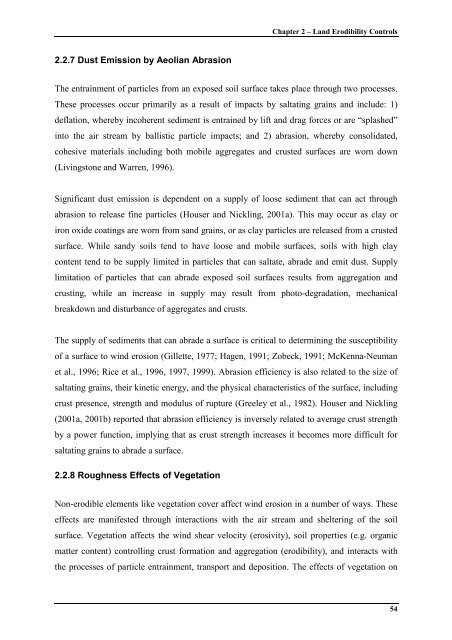Wind Erosion in Western Queensland Australia
Modelling Land Susceptibility to Wind Erosion in Western ... - Ninti One
Modelling Land Susceptibility to Wind Erosion in Western ... - Ninti One
Create successful ePaper yourself
Turn your PDF publications into a flip-book with our unique Google optimized e-Paper software.
Chapter 2 – Land Erodibility Controls2.2.7 Dust Emission by Aeolian AbrasionThe entra<strong>in</strong>ment of particles from an exposed soil surface takes place through two processes.These processes occur primarily as a result of impacts by saltat<strong>in</strong>g gra<strong>in</strong>s and <strong>in</strong>clude: 1)deflation, whereby <strong>in</strong>coherent sediment is entra<strong>in</strong>ed by lift and drag forces or are “splashed”<strong>in</strong>to the air stream by ballistic particle impacts; and 2) abrasion, whereby consolidated,cohesive materials <strong>in</strong>clud<strong>in</strong>g both mobile aggregates and crusted surfaces are worn down(Liv<strong>in</strong>gstone and Warren, 1996).Significant dust emission is dependent on a supply of loose sediment that can act throughabrasion to release f<strong>in</strong>e particles (Houser and Nickl<strong>in</strong>g, 2001a). This may occur as clay oriron oxide coat<strong>in</strong>gs are worn from sand gra<strong>in</strong>s, or as clay particles are released from a crustedsurface. While sandy soils tend to have loose and mobile surfaces, soils with high claycontent tend to be supply limited <strong>in</strong> particles that can saltate, abrade and emit dust. Supplylimitation of particles that can abrade exposed soil surfaces results from aggregation andcrust<strong>in</strong>g, while an <strong>in</strong>crease <strong>in</strong> supply may result from photo-degradation, mechanicalbreakdown and disturbance of aggregates and crusts.The supply of sediments that can abrade a surface is critical to determ<strong>in</strong><strong>in</strong>g the susceptibilityof a surface to w<strong>in</strong>d erosion (Gillette, 1977; Hagen, 1991; Zobeck, 1991; McKenna-Neumanet al., 1996; Rice et al., 1996, 1997, 1999). Abrasion efficiency is also related to the size ofsaltat<strong>in</strong>g gra<strong>in</strong>s, their k<strong>in</strong>etic energy, and the physical characteristics of the surface, <strong>in</strong>clud<strong>in</strong>gcrust presence, strength and modulus of rupture (Greeley et al., 1982). Houser and Nickl<strong>in</strong>g(2001a, 2001b) reported that abrasion efficiency is <strong>in</strong>versely related to average crust strengthby a power function, imply<strong>in</strong>g that as crust strength <strong>in</strong>creases it becomes more difficult forsaltat<strong>in</strong>g gra<strong>in</strong>s to abrade a surface.2.2.8 Roughness Effects of VegetationNon-erodible elements like vegetation cover affect w<strong>in</strong>d erosion <strong>in</strong> a number of ways. Theseeffects are manifested through <strong>in</strong>teractions with the air stream and shelter<strong>in</strong>g of the soilsurface. Vegetation affects the w<strong>in</strong>d shear velocity (erosivity), soil properties (e.g. organicmatter content) controll<strong>in</strong>g crust formation and aggregation (erodibility), and <strong>in</strong>teracts withthe processes of particle entra<strong>in</strong>ment, transport and deposition. The effects of vegetation on54
















